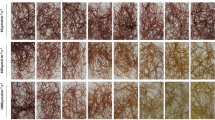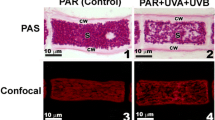Abstract:
The effects of light intensity, pH, temperature, and UV irradiation on the photosynthetic rate of Prochloron isolated from the ascidian host Lissoclinum patella, collected from Palau, were examined. Photosynthesis increased with light intensity with saturation at 500 μmol/m2 per second. It was maximum at pH 8 to 9 but almost completely suppressed below pH 7. The optimum temperature was 35° to 40°C, but the photosynthesis was absent at ≤20°C and at 45°C. It was recovered when the symbiont was transferred from 1 hour of incubation at ≤20°C to 35°C but not when transferred from incubation at 45°C. Ultraviolet irradiation severely inhibited the photosynthesis of Prochloron in isolation but not in vivo. This protection was brought about by the tunic covering the ascidian colony, which contains UV-absorbing mycosporine-like amino acids. These results indicate that the characteristic condition of the tropical marine environment largely determines the ecological distribution of Prochloron, and the ascidian tunic protects the organism from UV radiation.
Similar content being viewed by others
Author information
Authors and Affiliations
Additional information
Received February 17, 2000; accepted August 8, 2000.
Rights and permissions
About this article
Cite this article
Dionisio-Sese, M., Maruyama, T. & Miyachi, S. Photosynthesis of Prochloron as Affected by Environmental Factors. Mar. Biotechnol. 3, 74–79 (2001). https://doi.org/10.1007/s101260000062
Issue Date:
DOI: https://doi.org/10.1007/s101260000062




